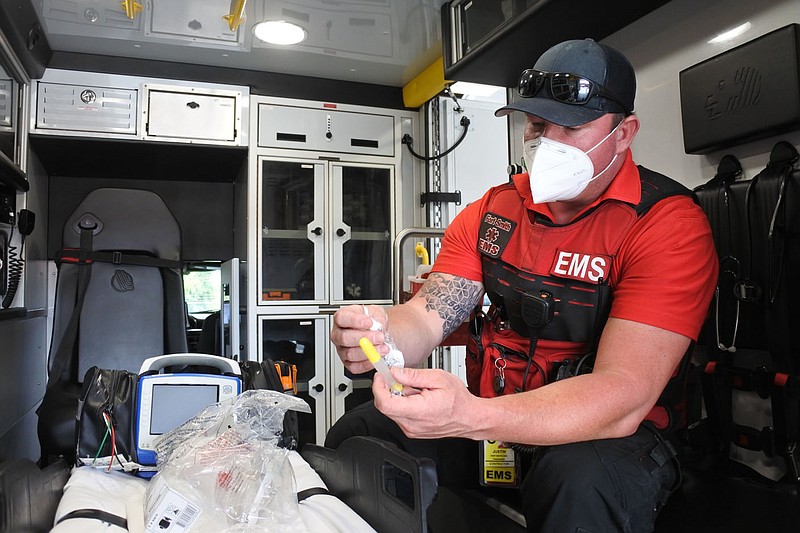FORT SMITH -- Local entities have reported seeing more fentanyl in the River Valley in recent years, as well as the consequences that can result from using it.
Cody Elliott, coordinator for the 12th and 21st District Drug Task Force, said his office is buying more fentanyl during its operations now than it did about a year-and-a-half ago. This includes fentanyl powder, heroin with fentanyl mixed in and pill-form fentanyl made to look like other medications.
Elliott estimated the task force, which assists narcotics investigations for agencies in Sebastian and Crawford counties, has been making about 10-20 monthly arrests related to fentanyl in the last six months. He said fentanyl and heroin both hit the area about the same time. He has seen heroin almost weekly since assuming his current position about a year ago.
"Probably two years ago, it was pretty rare to find or buy heroin from anyone, and now it's a lot easier to find," Elliott said. "There's definitely more of it out there. It's more being smuggled into the United States, and it's hitting our area pretty strong. Most of your opiate users are using heroin, which moves into the fentanyl."
The U.S. Drug Enforcement Administration website describes fentanyl as a synthetic opioid about 100 times more potent than morphine and 50 times more potent than heroin as a painkiller. It is a Schedule II narcotic under the federal Controlled Substances Act of 1970, meaning it is considered dangerous and has a high potential for abuse with the potential to develop "severe psychological or physical dependence."
Other opioids in this category include oxycodone, methadone, morphine and hydrocodone, according to the website.
The increased presence of fentanyl in the River Valley was also noted by Aaron Howell and Justin Yauger, a quality assurance manager and paramedic field supervisor, respectively, for Fort Smith EMS.
Yauger said the organization administered Narcan to patients 93 times from January to August 2020 compared to 141 times in the same period this year. Narcan is the name brand of the drug naloxone and reverses the effects of an opioid overdose.
Yauger said although Fort Smith Emergency Medical Service, which serves Fort Smith and Barling, can't pinpoint the cases as always being caused by fentanyl, he believed the increase in Narcan administration is probably due to the drug.
"And also, we're seeing more patients that are veteran heroin addicts, like the ones that you normally wouldn't see because they've been doing it for years and getting by, and then now they're getting fentanyl probably and unable to know how much of a dose that they're getting," Yauger said. "And so we're actually seeing people that we've never really seen that often before."
Yauger said the numbers don't reflect certain situations, such as when Fort Smith EMS revives someone by giving them oxygen.
The River Valley is following national trends. The 2020 Drug Enforcement Administration National Drug Threat Assessment said the number of drug overdose deaths that could be attributed to synthetic opioids other than methadone, such as fentanyl, increased dramatically throughout the country during the past decade. It cited the Centers for Disease Control and Prevention in stating that such deaths rose from 1,742 in 2005 to 31,335 in 2018.
"Deaths in this category increased approximately 10% from 2017 to 2018, likely attributable to increased availability of illicit fentanyl, as rates for fentanyl prescriptions and production have not risen in conjunction with the rise in fatal overdoses," the assessment states.
The 12th and 21st District Drug Task Force stopped field testing fentanyl because of the danger that comes with handling it. Officers send it to the Arkansas State Crime Lab in Little Rock for analysis to limit the chance for exposure.
"The dangerous thing about it is, it's transdermal," Elliott said. "You can get it through your fingers. You can inhale it if it's in a powder form. It's a pinhead's amount to be dangerous."
Howell said fentanyl can be cut into other drugs as well.
Examples of the danger fentanyl poses can be seen in recent reports by local law enforcement.
Capt. Philip Pevehouse with the Sebastian County Sheriff's Office wrote in a news release Aug. 24 deputies at the county jail found two female inmates unresponsive and not breathing in their cell that afternoon. Both women were revived after receiving Narcan and taken by ambulance to a hospital, with other inmates confirming the two had taken fentanyl.
Two deputies who had returned to the pod area were overcome by fentanyl residue, with another female inmate beginning to have seizures soon afterward, according to Pevehouse. All three were also hospitalized.
Aric Mitchell, spokesman with the Fort Smith Police Department, reported Sept. 1 an officer became unresponsive after coming into contact with fentanyl during a multiagency narcotics investigation that day. It took three doses of Narcan -- two administered with nasal spray and one given intravenously -- to produce the "desired results," after which the officer was taken to a hospital.
Elliott said the drug task force is trying to arrest people selling fentanyl in the area.
"I feel like we're trying to do everything we can to combat it and get it off the streets," he said. "I mean, we can get two or three, but there might be five or six others that are doing it. It's constant."
More News
Sources for Fentanyl
Mexico and China were identified as primary sources for fentanyl and fentanyl-related substances directly trafficked into the United States in 2019. India was also described as a source for “finished fentanyl powder and fentanyl precursor chemicals.”
Source: Drug Enforcement Administration intelligence report, Fentanyl Flow to the United States, January 2020.

